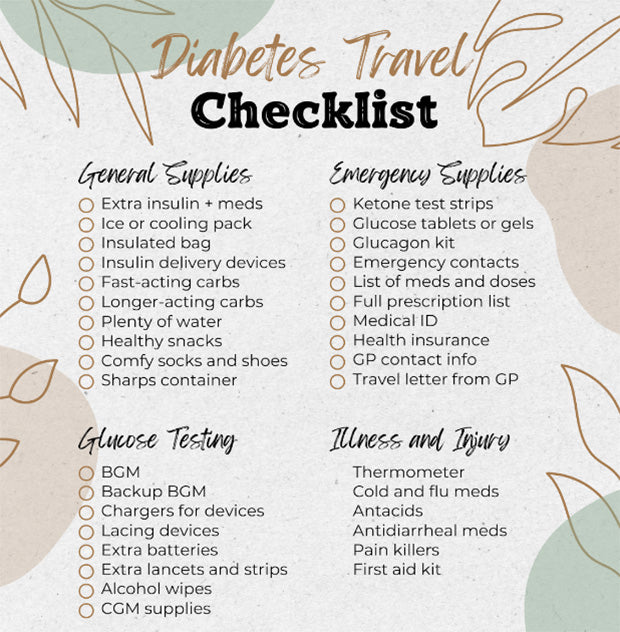Whether taking a road trip, traveling by plane, or going on a cruise, traveling has a way of messing with our daily routines. That’s true for anyone; however, for people living with diabetes, sticking to a daily self-care routine is essential for maintaining healthy blood glucose levels.
Traveling with diabetes can be overwhelming—but with a little extra planning, you can enjoy your time away from home without worrying about derailing your diabetes management. This article will provide tips for traveling with diabetes and answer frequently asked questions about diabetes and TSA.
Checklist for Traveling With Diabetes
Because people living with diabetes have unique considerations to take into account, planning ahead is essential. Here are some of the most important items to include while packing, plus some helpful tips to ensure safe, worry-free travels.
To be more thorough, we've compiled a list that includes both common and less frequently used items by people with type 2 diabetes. It is listed below for your consideration.

| Tips for Smooth Travel | |
| General Tips |
|
| Tips for Crossing Time Zones |
|
| Tips for Traveling by Car |
|
| Tips for Traveling by Plane |
|
Diabetes and TSA: FAQ
Which diabetes supplies are permitted through security?
Medically necessary diabetes-related supplies, equipment, and medication are allowed through the security checkpoint after proper screening via X-ray or hand inspection. TSA recommends that you notify the TSA officer that you have diabetes and are carrying your supplies with you when you arrive at the security checkpoint. The following items are permitted through security:
- Blood glucose testing kits (e.g., BGMs, lancing devices, lancets, test strips, batteries, and alcohol swabs)
- CGMs
- Oral diabetes medications
- Insulin
- Insulin pumps and insulin pump supplies (must be accompanied by insulin)
- Unused syringes (must be accompanied by insulin and be declared to TSA officers at the checkpoint)
- Used syringes (must be transported in a sharps disposal container)
- Ketone test strips
- Liquids (e.g., water, juice, and gels)
- Glucagon emergency kits
- Sharps disposal containers
What does the screening process look like if you wear an insulin pump?
If you have an insulin pump or other wearable medical device, TSA recommends letting the TSA officer know you have a medical device attached to your body and informing them of its location prior to the screening process. If your device is attached to your body, the device is subject to additional screening (e.g., visual inspections, self-patdown on the pump, hand swabbing, etc.).
What if my diabetes supplies contain liquids over 3.4 ounces?
If you’re traveling with diabetes supplies that are liquids (e.g., insulin, juice, or cooling gel packs), you likely don’t need to worry about the 3.4-ounce liquid rule. According to the CDC, people with diabetes are exempt from this rule for liquid diabetes-related supplies. TSA recommends letting the TSA officer know you have medically necessary liquids and placing them in a separate bin for X-ray screening.
Ready to Have Freedom at Your Fingertip?
POGO Automatic is the only FDA-cleared blood glucose monitor that lances and collects blood automatically, in one simple step, with its 10-test cartridge technology, eliminating the need to carry separate lancets and test strips. Reach out today to learn more about how you can check your blood glucose without interrupting your day.

|
Jaclyn OwensJaclyn Owens is a product director specializing in diabetes management tools. She is committed to using technology to empower people with diabetes and help them take control of their health. |
All content on this website is for educational purposes only and does not replace the guidance of your healthcare practitioner. Always seek the advice of your physician or other qualified healthcare provider with any questions you may have regarding a medical condition or treatment and before undertaking a new healthcare regimen, and never disregard professional medical advice or delay in seeking it because of something you have read on this website.
PL000356 Rev A




